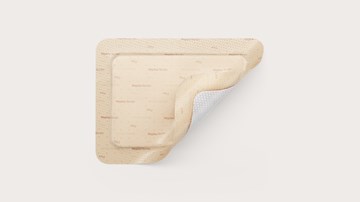Medicazione in schiuma “all-in-one”
Mepilex Border
Medicazione autoadesiva a cinque strati per le ferite acute e croniche
Mepilex® Border è una versatile medicazione in schiuma “all-in-one” con bordo disponibile in diverse misure e dimensioni. È possibile utilizzarla per trattare le ferite croniche e acute. Inoltre, è stato clinicamente dimostrato che contribuisce a prevenire le ulcere da decubito
La collaudata struttura a cinque strati include Safetac®, l’originale strato di contatto in silicone adesivo che riduce al minimo il dolore. Safetac è stato concepito per adattarsi delicatamente alla pelle senza attaccarsi alla ferita umida.
Lo strato assorbente trattiene l’umidità e l'essudato, proteggendo la cute perilesionale dalla macerazione
- Le medicazioni con Safetac riducono al minimo dolore e trauma al cambio della medicazione
- Versatile medicazione “all-in-one” per un’ampia gamma di ferite acute e croniche
- Efficacia dimostrata nel contribuire a prevenire le ulcere da decubito
- Eccezionale capacità di assorbimento dei fluidi
per un’efficace gestione dell'essudato con un minor rischio di macerazione - Riduce al minimo il rischio di strappo della pelle durante la rimozione
Ulteriori informazioni sul prodotto
Quando utilizzare Mepilex Border
È possibile usare Mepilex Border nel trattamento di un'ampia gamma di ferite essudanti acute e croniche e per le ferite che guariscono per seconda intenzione. La nostra medicazione morbida e conformabile mantiene un ambiente della ferita umido, per avere la certezza che assorba e trattenga efficacemente l'essudato.
Puoi scegliere da un’ampia gamma di dimensioni della medicazione, adatte a ferite piccole o grandi. Abbiamo anche medicazioni sagomate per ferite ubicate in aree difficili del corpo.
Mepilex Border può anche essere usata nell’ambito di un regime di prevenzione per contribuire a ridurre le ulcere da decubito.
È possibile riposizionare Mepilex Border dopo una valutazione cutanea.
Come utilizzare Mepilex Border
Guarda come applicare una medicazione “all-in-one” in schiuma Mepilex Border.
Come funziona Mepilex Border
Guarda come funziona Mepilex Border.
Prodotti correlati
'References'

 Mepilex Border
Mepilex Border













